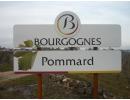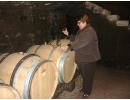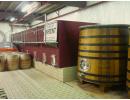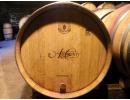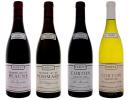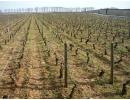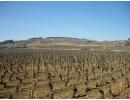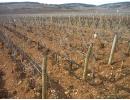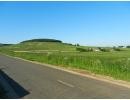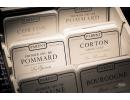Domaine Parent
Pommard 1 Cru "Les Chaponnières" 2014
Produced from a parcel of 0.63 ha of Pinot Noir, the old vines are 60 to 75 years of age producing an average yield of 45 hl/ha. Following the sorting the grapes are destemmed and a pre-fermentation skin maceration for 3 to 5 days at 8°C will be carried out. Cement vats are used for the fermentations that will last for 18 to 20 days at 27°C - 29°C. The ageing in french oak barrels will last 16 to 18 months with 30% - 40% of new oak and 60% - 70% are 1 to 4 years old.
Press: Burghound.com 90-93
Once again there is a subtle wisp of wood framing the beautifully fresh, cool and reserved aromas of various dark earth and soft sauvage scents. There are the hallmark soil tones present on the punchy and serious yet velvet-textured medium-bodied flavors that terminate in a firm, moderately austere and impressively long finish. I very much like the balance here and this is textbook Chaponnières. Recommended provided that you're willing to cellar this for at least 7 to 8 years first.
Wine Advocate 90 - 92
The 2014 Pommard 1er Cru les Chaponnières has more red fruit on the nose than the 2014 les Chanlins at the moment, more rounded and perhaps the oak better subsumed at this stage. The palate is medium-bodied with grippy tannin, a keen line of acidity, tapering in slightly towards the compact finish that will need time to open up. I like the finish here with its dash of black pepper and bay leaf. This is just delicious...and classy. Drink 2016 - 2032
Pommard 1 Cru "Les Epenots" 2014
Produced from 2 parcels representing 1.70 ha of Pinot Noir each located in the "Les Grands Epenots " and "Les Petits Epenots". The vines of the "Grands Epenots" are 28 years old and 55 years old for the "Petits Epenots", they produce an average yield of 45 hl/ha. Following the sorting the grapes are destemmed and a pre-fermentation skin maceration for 3 to 5 days at 8°C will be carried out. Cement vats are used for the fermentations that will last for 18 to 20 days at 27°C - 29°C. The ageing in french oak barrels will last 16 to 18 months with 30% - 40% of new oak and 60% - 70% are 1 to 4 years old.
Press: Burghound.com 91-93
An attractively fresh nose is composed by notes of plum and red berry fruit liqueur aromas that are trimmed in discreet wood and earth nuances. There is excellent richness, size, weight and concentration to the full-bodied yet relatively refined flavors that are underpinned by firm but fine tannins on the gorgeously complex and persistent finish. This is first-rate and well worth your interest, once again provided that you have the patience to cellar this beauty for at least 6 to 8 years first.
Wine Advocate 90 - 92
The 2014 Pommard 1er Cru les Epenots, which as usual constitutes a blend of lieux-dits (Pommard Grand and Petit Epenots), has a refined bouquet drawn along similar lines to the les Chaponnières, but here more floral and feminine. The palate is supple and fleshy in the mouth, the structure only apparent towards the sappy finish. There is a pleasing line and focus here that should hold it in stead for several years aging. Drink 2017 - 2030.
Corton Grand Cru "Les Renardes"
Produced from a parcel of 0.30 ha of Pinot Noir, the vines average 40 years of age producing an average low yield of 26 hl/ha. Following the sorting the grapes are destemmed and a pre-fermentation skin maceration for 3 to 5 days at 8°C will be carried out. Cement vats are used for the fermentations that will last for 18 to 20 days at 27°C - 29°C. The ageing in french oak barrels will last 16 to 18 months with 50% of new oak and 50% are 1 and 2 years old.
Corton Grand Cru 2009
Produced from a parcel of 0.28 ha of Chardonnay from the climats "Le Rognet" and "Corton" located on the commune of Ladoix-Serrigny. The vines planted on clayey-limestone soil towards the top of the slope average 23 years of age, producing an average low yield of 26 hl/ha. Following the sorting the grapes are whole bunch pressed. The fermentation will take about 3 weeks in french oak barrels (40% new) at 20°C - 22°C. The ageing in new french oak barrels will last 14-16 months on fine lees.
Burghound.com 90
Vestiges of post-bottling should disappear in due course and allow the ripe pear, white peach and soft mineral notes that are trimmed in discreet wood toast to have center stage. There is good richness and power to the overtly muscled and well-concentrated big-bodied flavors that possess good if not truly special complexity on the citrus-infused and solidly persistent finish.
The Family PARENT settled in Burgundy in 1640. After 5 generations in Volnay, Domaine Parent moved to the village of Pommard in 1803 under Claude PARENT (1770 - 1842). In 1789 Etienne Parent formed personal and professional ties with none other than Thomas Jefferson, the future President of the United States pioneering the export of Burgundy wines across the Atlantic. In 1947, Jacques Parent, then 19 years old, began working with his father Maxime before taking over the management of the Domaine in 1953.
Since 1998, the Domaine is managed by Anne and Catherine PARENT who took charge from their father Jacques (born in 1928), making them the 13th generation on the Domaine and for the first time in the family’s history, the first women to manage Domaine Parent. The Domaine was usually passed on from father to son until 1997 when their brother François married Ann-Françoise GROS and chose to be fully dedicated to the A-F Gros Domaine. Anne is in charge of the cellar and vineyards, while her sister Catherine looks mainly after the commercial and marketing aspects of the Domaine.
French version
The family owns 10 ha over different appellations which are: Pommard, Volnay, Beaune, Ladoix, Monthelie (white/red) and Corton Grand Cru (white/red). The heart of the Domaine is in Pommard with its communal wine and 6 parcels in Pommard Premier Cru in both the northern and southern areas of the appellation. As for the work in the vineyards, in 2000/2001 an organic approach was put into place, as Anne says “it is by personal conviction and not fashion”. In 2009, the whole 10 ha were converted to organic farming and the Domaine was officially certified organic in 2013. Wanting to go a step further in the expression of Pommard’s terroir and for the health of the environment, some biodynamic trials are being carried out on some parcels since 2010. As Anne says “the key for me is the balance between winegrowing and wine making, how to preserve the health of our environment and to produce finesse, elegance and complexity in the wine and the healthier the grapes, the better the wine”. The philosophy and hard work in the making of the wines over the years have made Domaine Parent one of the best producers for the typicity of the wines of Pommard.
Here are some details regarding some of the Domaine’s parcels:
Beaune 1 Cru “ Les Epenottes” is located next to the Pommard 1 Cru “Les Petits Epenots” and below the Beaune 1 Cru “Clos des Mouches” at the bottom of the slope. The terroir is a continuity of the plot in Pommard.
Pommard “La Croix Blanche” is situated opposite the famous Pommard 1 Cru “Les Grands Epenots” on the left side of the road as you enter the appellation driving towards the village of Pommard. The soil is of alluvium structure.
Pommard 1 Cru "Les Chanlins" is located to the south of the Pommard village. It is situated on the edge of the commune of Volnay facing east next to the famous 1 Cru climat "Les Rugiens Hauts". The terroir is rich in marl, brown limestone and clay with small rocks allowing a good drainage.
Pommard 1 Cru “Les Epenots” is a blend of "Les Grands" and "Les Petits Epenots" parcels that are situated at the entrance of the village Pommard on the right hand side coming from Beaune. The climats are surrounded by stone walls and the terroir is of brown limestone with marl and clay.
Pommard 1 Cru “Les Rugiens-Hauts” is situated southwest of the village above the 1 Cru “Les Rugiens-Bas” towards the top the slope facing east. The most powerful and firm Pommard come from here, the terroir is rich in marl, brown limestone and clay with small rocks allowing a good drainage.
Pommard 1 Cru “Les Chaponnières ” (Anne’s favourite Pommard) is just below the Pommard 1 Cru “Les Rugiens-Bas” as you come out of the village travelling south towards Volnay. The "climat" is situated at the bottom of the slope and the terroir is similar to “Les Rugiens”.
Corton Grand Cru “Les Renardes” (red) is located to the north of Beaune on the hill of Corton. The famous appellation Corton Grand Cru is the only red Grand Cru of the Côte de Beaune area and the largest Grand Cru of Burgundy with 90 ha. The parcel “Les Renardes” is situated mid-slope with its vineyards facing east on a terroir rich in brown limestone and marl.
Corton Grand Cru (white), also the name of the appellation, is made from chardonnay and it is a rare wine as it is produced by only 3 estates totaling 4.5 ha producing about 21,000 bottles. The whites from the hill of Corton are more commonly known as Corton-Charlemagne. Parent's plot is a minuscule 0.28 ha producing 83 cases only, located on the commune of Ladoix-Serrigny within the climat “Le Rognet” towards the top of the slope facing east, here the soil has a clay-limestone structure. Due to the appellation’s regulation the name of the parcel "Le Rognet" cannot be mentioned on the label in contrast with the red wine.
The Chardonnay grapes are hand-picked and two sorting tables are used, a vibrating table and a classic sorting table for a strict selection of quality grapes. The Chardonnay is pressed as whole bunches, indigenous yeasts are used in the fermentation process. The white Corton Grand Cru is produced from a low yield of 26 hl/ha with 23 year old vines. It is barrel fermented for 3 weeks and aged on lees in 100% new French oak barrels for 14 to 16 months, malolactic fermentions are carried out. The oak is very well integrated as not to over power the Chardonnay's aromas and flavours. It is somewhat fresher and dryer on the palate with a little less roundness compared to a Corton Charlemagne Grand Cru from the same area, these characteristic differences are due to the terroir. The wine can be cellared 10-15 years depending on the vintage.
The red wines of Domaine Parent from the various appellations are produced with the same approach with the yields defined by each appellation's regulation and the vintage's conditions, ranging from 45 hl/ha to as low as 26 hl/ha for the Corton Grand Cru "Les Renardes". Firstly most bunches are destemmed and pre-fermentation skin maceration will last 3 to 5 days to extract a little extra colour, flavours and tannins for the structure. All the reds are fermented in concrete vats which will last for 16 to 20 days depending on the wine's appellation and the quality of the vintage, only indigenous yeasts are used. Depending on the wine and the vintage all the wines are aged in french oak barrels with 30% to 50% of new oak and barrels of 1 to 4 year old.
On the palate, the wines tend to be taut with firm fine grain tannins in their youth, but then again that's what Pommard wines are renowned for. Throughout their cellaring life the wines remain elegant and well structured, the tannins soften out and the aromatic complexity and flavours evolve with elegance and finesse. Depending on the vintage and the appellation Domaine Parent's red wines may be cellared for up to 20 years such as the Corton Grand Cru “Les Renardes”.
The Pommard wine needs to be given time to open up to its fullest expression. Its chewy tannins will smooth out with cellaring and the wine will display its mouth-filling texture with a firm but delicate structure. Its aromas will evolve from fruity blackberry or gooseberry, cherry pit and ripe plum in its youth to leather, chocolate and pepper at it matures.
BURGUNDY POMMARD
Links: AOP Pommard - AOP Corton - Côte de Beaune map - www.bourgogne-wines.com
POMMARD
The appellation Pommard was designated in 1936, it is located between Beaune and Volnay in the Côte de Beaune area. The appellation covers 321 hectares which includes 28 Premiers Crus covering 122 hectares. For centuries Pommard has been considered the typical burgundy red wine to which all others should be compared. The fame of Pommard came about in the 19th century when it earned the image of a wine that is both forceful and virile, deep red in colour, powerfully aromatic, solid and trustworthy. They are the most masculine wines of the Côte de Beaune area. The lands were formally owned by the Dukes of Burgundy and monasteries such us the abbey of Cîteaux.
Only red wines from Pinot Noir are produced in the appellation. The best known Premier Cru are “Les Rugiens” and “Les Épenots”. The plot “Les Rugiens” was to be classified as a Grand Cru in 1936 but it never came about, as at the time the local growers refused the classification for the sake of not paying any extra taxes, today many growers regret their elders’ decision.
Vineyard
The geological base of Burgundy dates back to the Jurassic era about 130 -150 million years ago. About 60 million years ago, the geological shifts on the earth’s crust from the movement of continents, created the Alps mountain range and made the Bressan rift collapse creating a plain and the Saône ridge on the west side. This led to the creation of a unique landscape with outcrops of different rock layers from different eras. It is the weathering of the region over millions of years that has created Burgundy’s complex terroir. The soils are composed of clay-limestone, marl, limestone and brown clay, producing wines of different organoleptic characteristics. The best terroirs are usually located halfway up the slope in the middle of the ridge where the Grands Crus and Premiers Crus are situated. Pommard’s terroir can be defined as ancient alluvium deposit at the foot of the slopes near the plain with well drained marls and brown limestone soils at mid-slope.
The Vineyards are situated at an altitude of between 250 to 330 metres divided into two sections: the northern slope faces south, south-east between Pommard and Beaune and the southern slope faces east between Pommard and Volnay. The wines from the northern part show more finesse and elegance, where the most famous 1er Crus (Climat) are “Les Grands Epenots” and “Les Petits Epenots” situated towards the bottom of the slope. The most powerful and tannic wines of Pommard are from the southern area, here the 1er Cru “Les Rugiens”, just outside the village towards the top of the slope, is the most famous parcel for its Grand Cru potential.
Throughout Burgundy, the vineyard’s parcels are designated as “Climats”, “Lieu-dit” or “Clos” if they are surrounded by a stone wall. The names were given to precisely delineated plots of land that enjoy specific geological and terroir conditions. The “Climats” have their own unique organoleptic qualities such as their appearance, aromas, flavours, structure and texture. The “Climat” designation is usually used for Premier Cru and Grand Cru parcels while a “lieu-dit” is a name given to a plot. The concept of “Climats” was first mentioned as far back as the 7th century, such as Clos de Bèze a Grand Cru in Gevrey located in the Côte de Nuits area. These specific “Climats” and “lieux-dits” names can be mentioned on the label following the appellation’s name, for example: Pommard “La Croix Blanche”, Chassagne-Montrachet 1 Cru "Les Macherelles" or Corton Grand Cru “Les Renardes”. By mentioning the name on the label you can identify the exact area in the appellation were the fruit comes from. The Burgundians consider their “Climats” classification of Premier Cru and Grand Cru to be the pinnacle definition of “terroir” as it is the parcels that are classified and not the Domaine, where as in the case of the 1855 Bordeaux Classification it is the Châteaus that were classified from 5th Growth to 1st Growth, based on the quality and reputation of the wines produced. But of course their reputation and quality is also linked to the terroir.
Climate
The Côte d'Or is on the 47th parallel and the climate is classed as Continental, meaning winters (Dec-Jan-Feb.) can often be very cold with late frosts and summers (Jun-Jul-Aug) curiously like that of Bordeaux can occasionally reach extremely high temperatures. Micro-climates are another significant factor in the region as the heart of the Burgundian vineyards stretch over 50 kilometres from Dijon in the north to Chagny in the south. Most of the vineyards face east or east-south-east, benefiting from the morning sun. The vines are also sheltered by the hills from the wet westerly winds and because of their altitude they are not affected by fog and frost damage that occurs on the plains, but they might still be occasionally covered in snow during winter.



